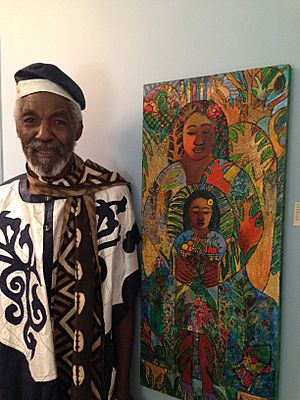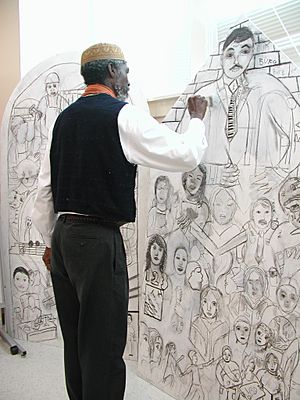Thomas James Reddy facts for kids
Quick facts for kids
"T.J." Reddy
|
|
|---|---|

Artist TJ Reddy in Charlotte, N.C
|
|
| Born |
Thomas James Reddy
8 June 1945 Savannah, Georgia, United States
|
| Died | 31 March 2019 (aged 73) Charlotte, North Carolina, United States
|
| Occupation |
|
| Spouse(s) | Marriage Vicky Minar, 1968 |
Thomas James "T. J." Reddy (born August 6, 1945 – died March 31, 2019) was an amazing American artist, poet, activist, and musician. He used his talents to create beautiful art and fight for what was right. Reddy was known for his powerful paintings, inspiring poems, and his strong voice for justice.
Contents
Reddy's Early Life and Education

T. J. Reddy was born in Savannah, Georgia. When he was a kid, black children were not allowed in public libraries. So, his school principal turned her own house into a library! Reddy loved to read and visited it often.
When he was 14, his family moved to New York City. In 1964, he moved to Charlotte, North Carolina. He studied at Johnson C. Smith University and then at the University of North Carolina at Charlotte.
At the university, he helped start the Black Student Union. This group worked to support black students. He also helped create the African and Afro-American Studies Department. This department taught about African and African-American history and culture.
During the 1960s, Reddy was very active in the Civil Rights Movement. He protested against the Vietnam War. He also spoke out against the military draft, especially how it affected the black community. He even visited military recruiting centers in different disguises to hand out anti-war flyers!
Reddy earned his first degree in History in 1974. Three years later, he got a Master's degree in Education. Later, in the late 1980s, he studied painting at Winthrop University.
Reddy's Fight for Justice
T. J. Reddy was a strong voice for justice. He was part of the Civil Rights Movement. He and two other black activists, James Grant and Charles Parker, were once turned away from a horse stable because of their skin color.
Later, these three men were wrongly accused of being involved in a fire. They were called the Charlotte Three. Reddy was sentenced to prison. However, it was later found that the main witnesses against them had been paid by the government.
After many appeals, the North Carolina Governor, Jim Hunt, finally released Reddy in 1979. Many people, including a writer for New York Times, believed this was a huge mistake by the justice system. They saw it as an unfair way to stop activists.
Today, you can find many of Reddy's letters and legal papers from this time. They are kept at the University of North Carolina at Charlotte library. They show his brave fight for what was right.
Reddy's Creative Career
T. J. Reddy was a talented artist, poet, and musician. While he was a student, he worked as a poetry consultant for an arts magazine called Three. In 1969, he won an award for his creative writing.
His poems appeared in many publications. He also published two books of his own poetry: Less Than a Score, But a Point (1974) and Poems in One Part Harmony (1980). Reddy loved the poetry of Beat poet Bob Kaufman. He was also inspired by French artist Marc Chagall, who was also a painter and poet.
Reddy's Art and Paintings
Reddy's paintings are known as Social Realist art. This means they show real life and often tell stories about society. His art often reflects the traditions of the Harlem Renaissance. This was a time when black artists, writers, and musicians created amazing works.
You can see his artwork in museums like the Tweed Museum of Art. His art is also at the University of North Carolina at Charlotte library. Reddy often used acrylic paints in his mixed media works. He also added natural materials like paper, sand, wood, fabric, and clay to his paintings.
Reddy was also famous for his murals and public art projects. Murals are large paintings on walls. His work was inspired by his travels to the Caribbean and islands in the southern United States. He also drew inspiration from the journeys of African and Caribbean people to the Americas.
His paintings are full of texture and tell stories. They have a spiritual feeling and show a deep love for culture. Reddy believed culture means shared human values.
In 2013, his work was shown in an exhibit about the Civil Rights Movement. This was at the Levine Museum of the New South in Charlotte. In 2014, he had his own art show at the York W. Bailey Museum.
Reddy's murals can still be seen on walls around Charlotte, his longtime home. He painted a special mural at the Charlotte Convention Center. This mural shows the lives of African Americans who once lived in that area. The convention center was built where a traditional African-American neighborhood used to be.
Reddy created many series of artworks. One series explored male archetypes, or common character types. These were inspired by the ideas of Swiss psychiatrist Carl Gustav Jung. The archetypes included the King, the Lover, the Warrior, and the Magician.
Music and Connection
T. J. Reddy also played music. One instrument he played was the kalimba. This is an ancient African instrument. Reddy said that playing it helped him connect with his deeper thoughts.
In 2017, Reddy explained how his art, poetry, and music were all connected. He said, "When you look at my paintings, I want you to sense the music, the lyrics in it." He wanted people to feel the rhythm and story in his art.
In the summer of 2017, a special art show called "Everything is Everything" celebrated Reddy's creative life. It showed many of his different artworks. These included paintings from his series like King Warrior Magician Lover and Blues Men and Women. The exhibit also featured his poetry books and other papers.
People described his paintings as having "four magic ingredients: color, symbolism, narrative, and transformation." His art was often called "social realism." But some felt it was more like "social surrealism," mixing real life with dream-like qualities.
Even after five decades of creating, Reddy continued to make new art. He worked on pieces about jazz and even sculpture. He believed his creative journey was always changing and growing.
Awards
- Recipient of the Kwanja Award for Creativity (1978)
- Recipient of the North Carolina Conference of Black Studies Service Award.

